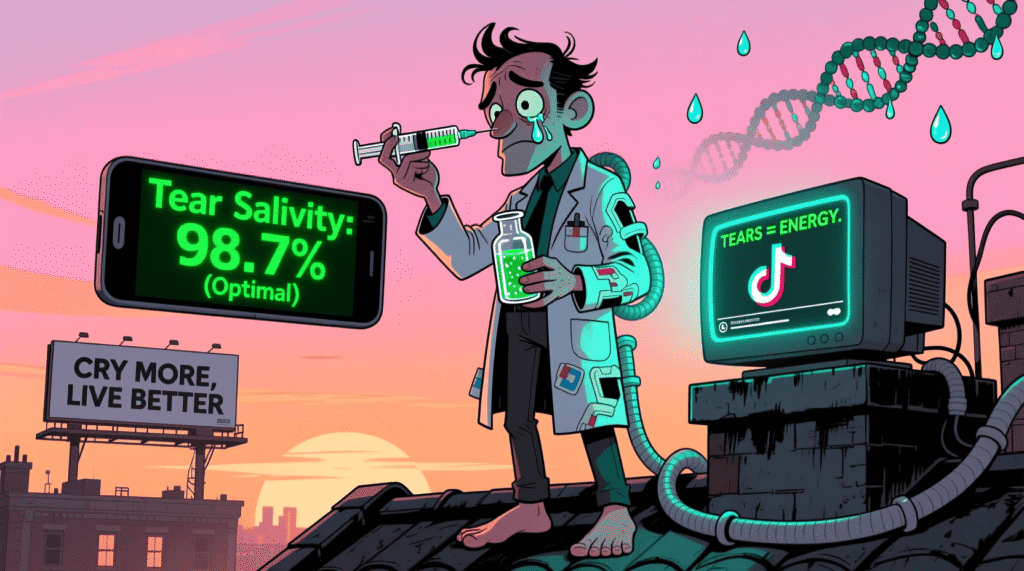In a world where “wellness” has replaced religion, biohackers have reached a new frontier of absurdity: drinking their own tears to achieve “optimal tear salinity.” Yes, you read that correctly. On TikTok and niche Substacks, a growing movement claims that tears—especially those shed during “mindful grief sessions”—contain “bioactive electrolytes” that “reset emotional pH” and “enhance cellular empathy.” One influencer even launched a $120/month “Tear Tonic” subscription, promising “lab-grade collection kits” and “salinity coaching.” This isn’t self-care. It’s self-cannibalism with a wellness filter.
The Viral Myth of Drinking Own Tears for Optimal Tear Salinity
The pitch is deceptively spiritual: “Your tears are data. Your grief is fuel.” Proponents argue that modern life desalts our emotional output—leading to “dry-soul syndrome”—and that re-ingesting tears restores “ionic balance.”
Two satirical fan testimonials capture the trend:
“I cried during my journaling, collected 3mL, drank it with lemon water. Felt 73% more authentic.” — @SalineSage
“My tear salinity was 0.7%. Now it’s 0.9%. My aura hasn’t been this clear since I stopped talking to my mom.” — @BioGriefGuru
The myth? That this is cutting-edge science.
The truth? It’s pseudoscience wrapped in linen robes—and sold as enlightenment.
The Absurd (But Real) Mechanics of Tear Biohacking
After investigating forums, product listings, and tear-tracking apps, we uncovered the full protocol:
- Step 1: Induce “Quality Tears” — Watch sad movies, read breakup texts, or meditate on climate collapse.
- Step 2: Collect with “Sterile Micro-Vials” — Sold by brands like AuraTears™ and CryoClarity.
- Step 3: Analyze Salinity — Using a $299 “TearScan” device that measures sodium, potassium, and “emotional residue.”
- Step 4: Re-ingest or “Amplify” — Mix with collagen, moon water, or CBD tincture.
One startup even offers “Tear Laddering”: storing tears from different emotional states (grief, joy, rage) and blending them for “emotional homeostasis.”
Meanwhile, a leaked email from a wellness brand read: “Position tears as the ultimate clean protein—zero carbs, 100% you.”
And yes—there’s merch:
– “I Cried So You Don’t Have To” T-shirts
– Tear pH test strips ($45 for 10)
– A $500 “Grief-to-Glow” coaching package
The Reckoning: When Wellness Becomes Self-Exploitation
This trend didn’t emerge in a vacuum. It’s the logical endpoint of a culture that treats the body as a hackable machine and emotions as data to be optimized.
As we explored in Unnecessary Science Coffee, wellness culture often invents problems to sell solutions. And as shown in Calorie Counting Satire, quantification has replaced intuition—even in grief.
High-authority sources confirm the drift into pseudoscience:
- Nature warns that “biohacking” often lacks peer-reviewed evidence and exploits scientific illiteracy.
- FDA has issued warnings about unregulated “body fluid” products, including tear-based tonics.
- American Psychological Association notes that pathologizing normal emotions (like crying) can increase anxiety.
The real cost? Not the $120/month subscription.
It’s the erasure of unquantified human experience—where even sadness must be measured, monetized, and re-ingested to be valid.
Conclusion: The Cynical Verdict
So go ahead. Cry into your vial.
Test your salinity.
Drink your grief like kombucha.
But don’t call it healing.
Call it capitalism with better hydration.
And tomorrow? You’ll probably buy a “Tear Starter Kit”…
because your sadness feels too free.
After all—in 2025, even your tears need a SKU.
